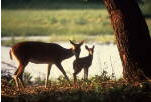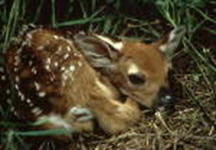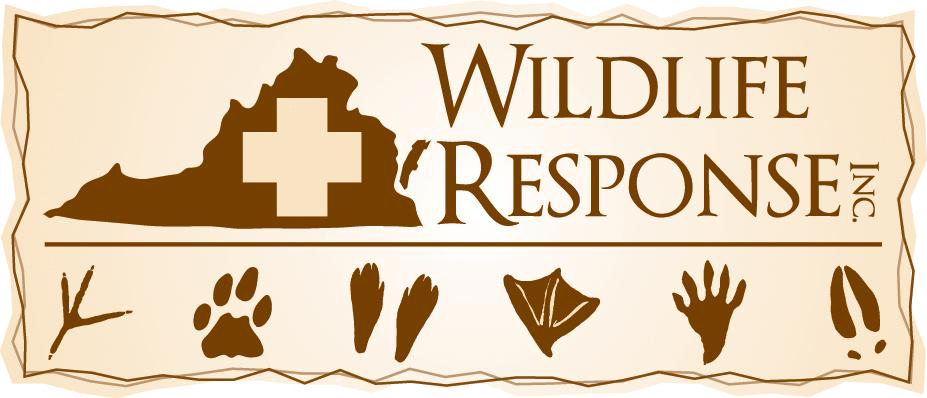(Odocoileus virginianus)
 White-tailed deer have played a very important role in the history of our country. A major part of Meriwether Lewi’s job was to observe and descried the flora and fauna of the Northwest. He had no reason to write about the common or fallow deer of the East Coast, except for eusing it for comparison purposes, he gave it a very good picture overall. The term “white-tail” occurred in the expedition’s journals only once, when Clark, on June 5, 1805, reported that he “Saw great numbers of Elk & white tail deer.” He was merely using it as a descriptor, not as a name. It didn’t come into popular usage until sometime in the 1860s.
White-tailed deer have played a very important role in the history of our country. A major part of Meriwether Lewi’s job was to observe and descried the flora and fauna of the Northwest. He had no reason to write about the common or fallow deer of the East Coast, except for eusing it for comparison purposes, he gave it a very good picture overall. The term “white-tail” occurred in the expedition’s journals only once, when Clark, on June 5, 1805, reported that he “Saw great numbers of Elk & white tail deer.” He was merely using it as a descriptor, not as a name. It didn’t come into popular usage until sometime in the 1860s.
They were used extensively by Native Americans for both food and clothing and also by the early settlers.
White-tailed deer are the smallest of the three members of the deer family found in North America, the others being elk and moose.
The white-tailed deer is the oldest species of deer in the world today, its first appearance dating back to the Pliocene, perhaps 3.5 million years ago. There are now 38 subspecies of the white tail occupying a range that extends from the jungles of northern South America to the fringes of Canada’s boreal forests, and from the Atlantic Coast to the Pacific Northwest.
 “White-tailed” refers to the distinctive white tail that when raised provides a flash of white signaling other deer when danger is near. They are graceful and swift runners that can reach up to 35 mph. Male deer are called “bucks”, females “does”, and baby deer “fawn”. They live in female-led family groups of up to 25 deer and can live as long as 10 years or more. Buck deer are primarily solitary animals except during the breeding season (also called the “rut”).
“White-tailed” refers to the distinctive white tail that when raised provides a flash of white signaling other deer when danger is near. They are graceful and swift runners that can reach up to 35 mph. Male deer are called “bucks”, females “does”, and baby deer “fawn”. They live in female-led family groups of up to 25 deer and can live as long as 10 years or more. Buck deer are primarily solitary animals except during the breeding season (also called the “rut”).
They have two seasonal coats. In the spring/summer their coat is reddish tan, relatively short, with thin and wiry hair. The winter coat is grayish or bluish tan with heavy, long hairs with a thick coat. White patches are found around the eyes, throat belly, inside of legs and underside of the tail. The fawns have white spots in a reddish-brown background enabling them to blend in with their surroundings. In the later part of the summer the fawn starts to loose it’s spots and they get a grayish coat. They are active around the clock, but less so during the daylight hours. They are usually on the move during the dawn and dusk. Deer have been recorded leaping heights of as much as eight (8) feet to clear a fence or barrier. We have identified at least 13 different sounds that they make for various activities and behaviors. Antlers play an important role in deer society. Rubbing the antlers on trees marks territories and sparring matches.
 White-tailed deer prefer an area with diverse food and cover types. The perfect habitat would include a mixture of forest, brushland, cropland and fields. They eat a variety of items; some of the items are: wild crabapple, corn, sumac, Japanese honeysuckle, grasses, greenbriar, clover soybeans, jewelweed, acorns, and not limited to dogwoods.
White-tailed deer prefer an area with diverse food and cover types. The perfect habitat would include a mixture of forest, brushland, cropland and fields. They eat a variety of items; some of the items are: wild crabapple, corn, sumac, Japanese honeysuckle, grasses, greenbriar, clover soybeans, jewelweed, acorns, and not limited to dogwoods.
 When born male fawns weigh about 4-14 pounds and femails 3-8 pounds. They are born with their eyes open and can walk within 1-2 hours. Fawns nurse 2-3 times a day. They come out of hiding to nurse then go back into hiding. At about one month the fawn begins to accompany their mother. They will stay together until the following spring. Female fawns will remain in proximity to their mother their whole life. The bucks are forced to leave in the fall, if they haven’t already.
When born male fawns weigh about 4-14 pounds and femails 3-8 pounds. They are born with their eyes open and can walk within 1-2 hours. Fawns nurse 2-3 times a day. They come out of hiding to nurse then go back into hiding. At about one month the fawn begins to accompany their mother. They will stay together until the following spring. Female fawns will remain in proximity to their mother their whole life. The bucks are forced to leave in the fall, if they haven’t already.



